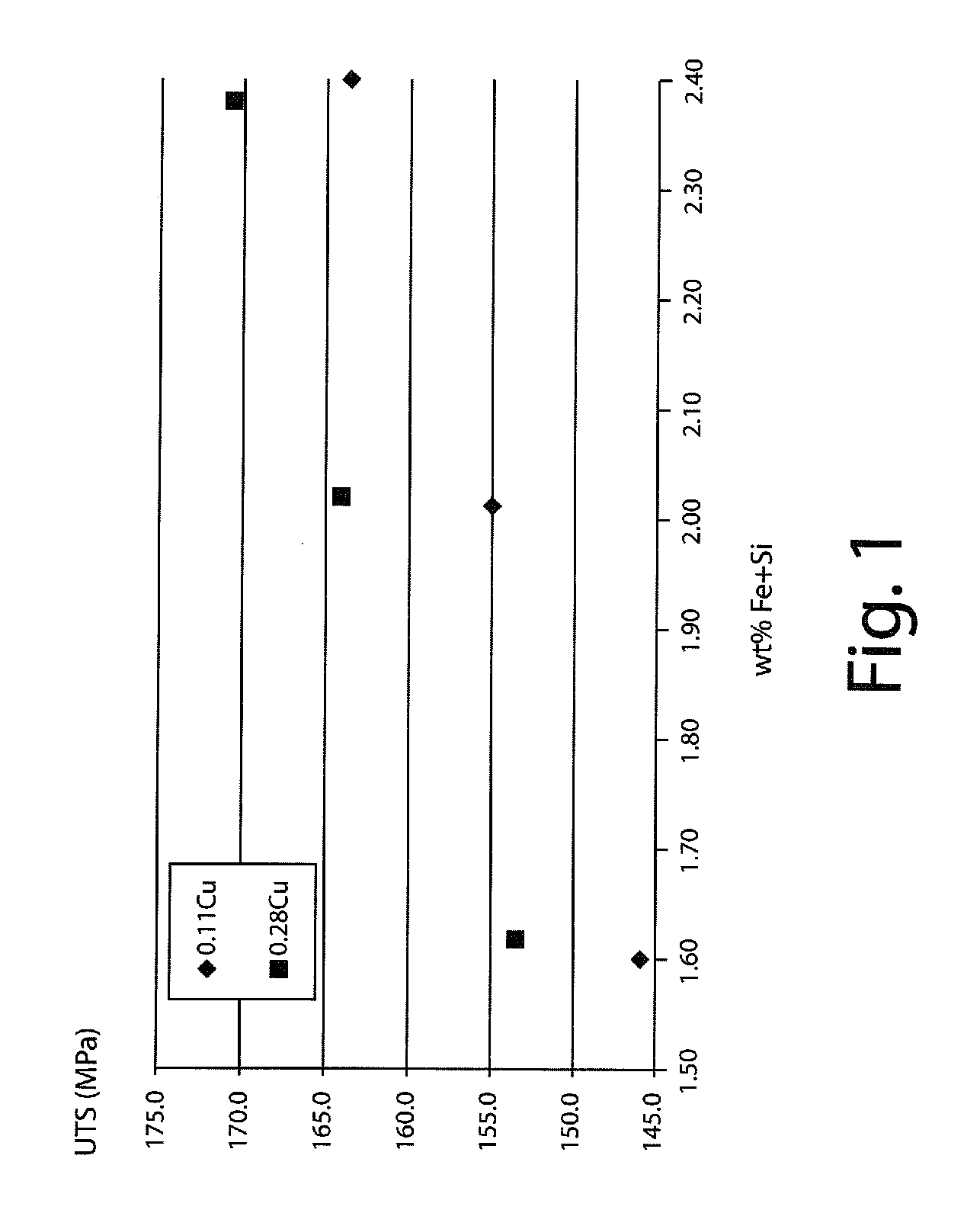Aluminum fin alloy and method of making the same
- Summary
- Abstract
- Description
- Claims
- Application Information
AI Technical Summary
Benefits of technology
Problems solved by technology
Method used
Image
Examples
example 2
[0045]2 further alloy compositions were tested that incorporated additions of Zn. The alloy compositions are shown in Table 3, (all values in weight %).
TABLE 3Sample #FeSiMnCuZnE0.900.890.780.200.34F0.960.930.950.180.47
[0046]In each case other elements present as impurities and trace elements were <0.05 and the balance was Al.
[0047]Alloys according to each sample were twin roll cast to a gauge of 6.0 mm. Sample E was interannealed after hot rolling at an intermediate gauge of 0.78 mm with a peak furnace temperature of 420° C. for a total cycle time of 35 hrs and then cold rolled to a final gauge of 0.052 mm to provide material in an H18 temper.
[0048]Sample F was also provided in an H18 temper but with the interanneal occurring after hot rolling at a gauge of 0.38 mm, with the same interanneal temperature and duration as sample E.
[0049]The final gauge finstock was then subjected to the same brazing cycle as described in Example 1.
[0050]Tensile properties were measured in the normal m...
example 3
[0052]The alloys described in Table 5 were cast in “book-mould” sizes, 25 mm×150 mm×200 mm. The cast ingots were pre-heated from room temperature to 525° C. over 9 hrs and allowed to soak for 5.5 hrs. They were then hot rolled to a gauge of 5.8 mm followed by cold rolling to 0.1 mm gauge.
TABLE 5Sample #FeSiMnCuFe + SiG1.011.001.010.112.01H1.011.011.000.282.02J0.810.791.000.111.60K0.820.801.010.291.62L1.211.191.010.112.40M1.201.181.000.292.38
[0053]In each case other elements present as impurities and trace elements were <0.05 and the balance was Al.
[0054]They were then subjected to the same controlled-atmosphere brazing cycle as described in examples 1 and 2 and tensile tested for post-braze UTS. The properties are shown in Table 6.
TABLE 6Sample #UTS (MPa)G155.0H164.0J145.8K153.5L163.5M170.6
[0055]FIG. 1 illustrates that, as the Fe+Si content increases, so too does the UTS after brazing and that increasing the Cu content for the same Fe+Si content also increases the UTS after brazing....
PUM
| Property | Measurement | Unit |
|---|---|---|
| Temperature | aaaaa | aaaaa |
| Fraction | aaaaa | aaaaa |
| Percent by mass | aaaaa | aaaaa |
Abstract
Description
Claims
Application Information
 Login to View More
Login to View More - R&D
- Intellectual Property
- Life Sciences
- Materials
- Tech Scout
- Unparalleled Data Quality
- Higher Quality Content
- 60% Fewer Hallucinations
Browse by: Latest US Patents, China's latest patents, Technical Efficacy Thesaurus, Application Domain, Technology Topic, Popular Technical Reports.
© 2025 PatSnap. All rights reserved.Legal|Privacy policy|Modern Slavery Act Transparency Statement|Sitemap|About US| Contact US: help@patsnap.com

